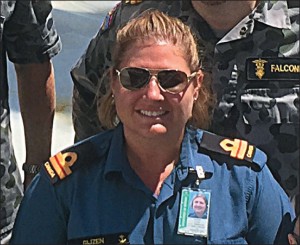
Lt(N) Lucie Gijzen on board MV Besant.
Rachel Lallouz, Staff Writer – Lieutenant(Navy) Lucie Gijzen, a physician working at Canadian Forces Health Services Centre (Pacific) isn’t your average doctor.
On top of her duties as a Primary Care Physician, she travels the world to collaborate in submarine escape and rescue working groups in NATO countries, and participates in international submarine escape and rescue exercises.
She is one of six physicians in the Canadian Armed Forces trained in the field of diving and submarine medicine.
Her highly specialized medical training in hyperbaric and submarine medicine recently earned her a spot on a team of 25 medical personnel selected for Exercise Black Carillon 2015 (BC15). The submarine escape exercise took place Sept. 14 to Oct. 9 at the Royal Australian Navy’s (RAN) base HMAS Stirling in Perth, Western Australia.
“The exercise was designed to provide massive casualties training to medical personnel trained in submarine medicine, to give submariners a chance to abandon a vessel in a real-life scenario, and to provide the RAN a chance to practice aero medical evacuations,” explained Lt(N) Gijzen. “All while using the RAN’s new intervention vessel for the first time, MV Besant.”
She adds this type of exercise is important “because we need to be ready in the event that a submarine is in distress. We need to be able to keep our submariners safe.”
The first few days of the exercise saw Australian submarine HMAS Rankin bottomed in 19 metres of seawater in Cockburn Sound, off the coast of Western Australia. Six James Fisher Defence instructors from the Submarine Escape Training Facility at HMAS Stirling were situated inside the submarine, ready to escape through the submarine’s single man escape tower in inflatable survival suits, buoying them to the surface.
The scenarios for the exercise replicated a submarine collision with another vessel or sea mount, or an onboard flood or fire – all of which would make the vessel inoperable and result in being disabled on the seabed.
“We medical personnel were on scene a short distance away onboard MV Besant, which was built to assist submarines in distress, and to treat the submariners,” explains Lt(N) Gijzen.
Unlike a typical rescue vessel, MV Besant is equipped with recompression chambers, a full resuscitation area, extensive berth facilities to hold the injured, and three separate treatment areas covering the varying levels of injuries, from the walking wounded to life threatening injuries.
Also participating were two RAN search and rescue paramedics, eight members of the ship’s crew, and more than 30 international observers from as far as Singapore and Sweden.
Lt(N) Gijzen’s was a member of the Directing Staff, coordinating with the command rescue force located on the bridge, and directing the casualties on how to “act” out their injuries in triage. She was also responsible for noting the medical staff’s response to particular injuries and providing feedback.
Once the submarine was resting on the sea floor, the six individuals inside the submarine donned their recue suits, attached themselves to an air supply, and then inflated the suit. They escaped through the submarine’s escape hatch. Medical RAN technicians stationed in smaller rescue vessels close to the submarine pulled the casualties from the water and transported them back to MV Besant for treatment and medical management.
Over the course of four days, a total of 25 casualties were treated, from head injuries to fractures, to burns or complex respiratory problems that could result from a submarine’s incident. Some casualties were identified with more classic injuries associated with the change in atmospheric pressure, such as decompression illness, where nitrogen bubbles travel through the blood to the brain or other parts of the body.
“An aterial gas embolism is a life-threatening situation,” says Lt(N) Gijzen. “We had these casualties moved to the decompression chambers on board right away to reduce the bubbles and resolve the associated symptoms. Some bubbles might also move to the person’s joints, resulting in musculoskeletal-type pain throughout the body. The physicians really had to be working their diagnostic criteria to identify what the problem was and treat accordingly.”
From sunrise until early evening, physicians were placed in triage, at the recompression chambers, and at each level of treatment area – T1, for life-threatening injuries, T2 for serious injuries, and T3 for minor injuries –where they worked in conjunction with the bridge officers to practice the casualty scenarios.
The most serious of all casualties was tested. A person with a traumatic brain injury who could not be stabilized needed to be seen by a neurosurgeon immediately. This meant an aero medical evacuation from MV Besant to a hospital.
Rather than practice on a live casualty, a 60 kilogram dummy (Oscar) was used. A rescue helicopter hovered above MV Besant’s deck, and lowered down a folded stretcher and a rescue member using a long cable. Oscar was then loaded onto the stretcher by the rescue member, and both were lifted back into the helicopter, bound for Fiona Stanley Hospital in nearby Perth.
Overall, Lt(N) Gijzen says, “International co-operability in these training exercises is key since we don’t know when we may require assistance from other nations. Ultimately, we need to continue to train as an international community to keep submarine forces safe all over the world.”














